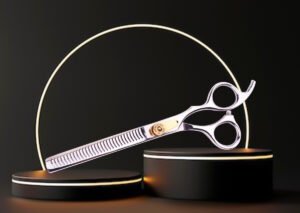For professional hairstylists, maintaining the tools of the trade is essential for delivering consistent, high-quality results. One of the most important aspects of maintaining your hair cutting scissors is ensuring that the tension is properly adjusted. The tension screw, a small but crucial component of your scissors, allows you to fine-tune the pressure between the blades. This adjustment can make the difference between a smooth, effortless cut and a frustrating, uneven one.
In this blog post, we’ll guide you through the steps to adjust the tension screw on your hair cutting scissors for optimal performance.
Why Adjusting the Tension Matters
Before diving into the how-to, let’s briefly discuss why adjusting the tension is so important:
- Proper tension ensures that the blades glide smoothly over each other, cutting cleanly through the hair without requiring excessive force.
- Correct tension reduces the strain on your hands and wrists, especially during long cutting sessions.
- By preventing the blades from rubbing against each other too tightly or too loosely, proper tension extends the lifespan of your scissors.
- Tension that’s just right allows for more precise cuts, making it easier to achieve the desired hairstyle.
How to Adjust the Tension Screw
Step 1: Identify the Tension Screw
First, locate the tension screw on your scissors. It’s typically found at the pivot point where the blades cross. Depending on your scissors, the tension adjustment may be a traditional screw, a dial, or a flat screw with a decorative knob.
Step 2: Check the Current Tension
Before making any adjustments, it’s important to test the current tension. Open your scissors so that the blades form a 45-degree angle, and then perform the drop test:
- Hold the scissors horizontally with one handle.
- Allow the other handle to drop freely.
- Observe how the blades move. If the blades close too quickly, the tension is too loose. If they barely move or don’t move at all, the tension is too tight.
Step 3: Adjust the Tension
Once you’ve determined whether the tension is too loose or too tight, it’s time to make adjustments:
For Scissors with a Traditional Screw:
- Use a small screwdriver to turn the screw.
- To tighten the tension, turn the screw clockwise.
- To loosen the tension, turn the screw counterclockwise.
- Make small adjustments, typically a quarter or half turn at a time.
For Scissors with a Dial or Knob:
- Turn the dial or knob in the direction indicated for tightening or loosening.
- As with traditional screws, make small adjustments and recheck the tension.
Step 4: Re-Test the Tension
After making an adjustment, repeat the drop test to see if the tension is correct:
- If the blades move and stop halfway, the tension is just right.
- If further adjustment is needed, continue making small turns and testing until the ideal tension is achieved.
Step 5: Lock in the Tension
Some scissors come with a tension lock mechanism to keep the screw from loosening or tightening on its own. If your scissors have this feature, be sure to engage the lock after adjusting the tension.
Step 6: Perform Regular Maintenance
Adjusting the tension should be part of your regular scissor maintenance routine. Regular use can cause the screw to loosen over time, so it’s important to check and adjust the tension periodically.
Additional Tips
- Always refer to the manufacturer’s guidelines for specific instructions related to your scissors model.
- Over-tightening can damage the blades and screw mechanism. Always adjust in small increments.
- Dust and debris can accumulate around the screw, affecting its function. Clean the area regularly to ensure smooth adjustment.
Final Thoughts
Adjusting the tension screw on your hair cutting scissors is a simple yet essential task that ensures your tools remain in top condition. Proper tension not only enhances cutting performance but also extends the life of your scissors, making your work more efficient and comfortable. By regularly checking and adjusting the tension, you can maintain the precision and quality of your haircuts, keeping your clients happy and your hands strain-free. Remember, a little maintenance goes a long way in preserving the performance of your most important tool.



